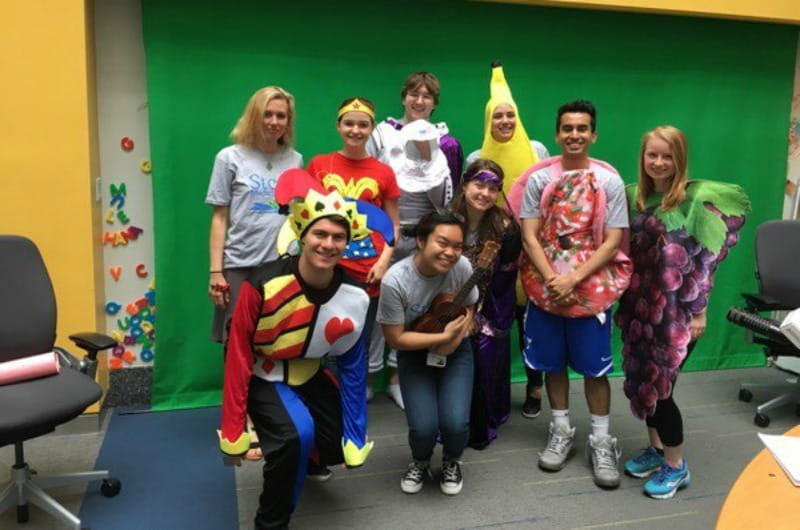Drexel Students Deliver a Weekly Dose of Fun at CHOP
 By Ben Seal
By Ben Seal

You might not encounter a ukulele player in a banana suit in many college classes, but “Story Medicine” isn’t much like the rest. When you’re putting on a show for young children, the usual boundaries of a college course get stretched to the point where it all begins to make some sense, though.
“Story Medicine,” which takes Drexel University students to the Children’s Hospital of Philadelphia to perform in-house programming for the hospital’s young patients, isn’t your average class. It builds students’ writing and performance skills all while leaving a lasting impact on their excited and engaged audience members. Once a week, students visit the hospital’s Seacrest Studios to act out scripts they write themselves. The shows take place in front of a live crowd and are broadcast throughout CHOP for any children who can’t attend in person. Add in some audience interaction and it all makes for an unpredictable experience that falls right in line with the University’s push to maximize civic engagement.
“So many people say they want to get involved but they don’t know how,” said Hannah Krupa, a communication major in the College of Arts and Sciences who took the class this spring. “You can just walk into this class and have a place to do that with these programs that already exist.”
“Story Medicine” is one of several community-based learning courses at Drexel, all of which take students outside of the classroom to partner with local organizations and make a difference in some way. In this case, that means entertaining children by any means necessary. And that’s how Vida Manalang, a pre-med psychology major, found herself in a banana suit, strumming the ukulele while she and Krupa sang songs about the building blocks of story: character, plot, dialogue, theme.
“They just love seeing us do these things and sing these songs and wear these costumes and work on the fly with what they’d like to do,” said Manalang. “We learned a lot from it. We’re always thinking we have to be super prepared or everything will go wrong. But to see how it was the most spontaneous moments that made our visit worth it, it brought a lot of playfulness to it.”
Spontaneity is baked into the class — what else could come from having students flex their creative writing muscles to produce weekly half-hour scripts? The result is a series of fun, imaginative stories about magic, candy, fairies, dragons and more, each of which has to teach the children watching about fundamental storytelling concepts. Manalang said the performances are shot through with “the pure joy of creating.” Kids are welcomed to participate, either in the studio itself or by calling in from their rooms. There is also an arts and crafts element, led by any Drexel students who aren’t performing on a given day.
Nomi Eve, the assistant teaching professor in the College of Arts and Sciences’ Department of English and Philosophy who teaches “Story Medicine,” wasn’t sure what to expect when CHOP approached Drexel asking if there were students who could help produce programming for patients. But she knew immediately that she wanted to be a part of it.
“Students have told me this experience is really life-changing for them,” said Eve. “They have really intense experiences with patients and they see patients as real people, not as somebody with an illness or a disability, but as a child who is joyfully painting or getting on camera.”
The depth of those experiences keeps students coming back for more. Each of the four times Eve has taught the class so far, students have gone on to apply for co-ops at CHOP. Manalang signed up to volunteer at the hospital “in any way possible” after taking “Story Medicine” in the spring. She and Krupa both plan to return to the studio for the “Story Medicine” section that opens in the fall term. They won’t be getting credit, but they want to stay involved and help the project grow. There are more elements the class could incorporate — more music, some dance, perhaps even animation — that will only strengthen its impact on CHOP patients and their families. Eve said she’s especially interested in adding actors to the class.
“Nomi wants to grow this project and I want to help her do that,” said Krupa, who joined “Story Medicine” in search of more community engagement after her spin through CIVC 101. “There could be so many added elements to this for kids to be involved.”
Each session of “Story Medicine” builds on the last. Scripts from one class can be updated and reused by the next, and the songs Manalang and Krupa wrote and recorded will become mainstays for future shows. There’s plenty of room for the class to grow into something even more beneficial for both students and CHOP patients.
There aren’t many college classes so rewarding that students will attend even without getting credit, but there aren’t many college classes quite like “Story Medicine.”
“It was an outlet. It was a relief. It brought so much light and sunshine into my week,” said Manalang. “It was something I looked forward to in the midst of all we do that’s so fast-paced. It was a beacon.”
[iframe width="100%" height="450" scrolling="no" frameborder="no" src="https://w.soundcloud.com/player/?url=https%3A//api.soundcloud.com/playlists/338798889&auto_play=false&hide_related=false&show_comments=true&show_user=true&show_reposts=false&visual=true"][iframe]
In This Article
Drexel News is produced by
University Marketing and Communications.
